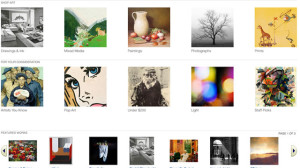Still in beta, Amazon recently launched Amazon Fine Art where 150 galleries have come together to sell over 4,000 pieces of 2-dimensional works of unique collectible fine art. And it’s serious — the highest end (for the fine art department and retailer as a whole) is Norman Rockwell’s Willie Gillis, listed at $4,850,000.00. You can also buy art for as little as $10. Between your car parts, textbooks and same-day fresh grocery delivery (sorry Bay Area, for now only in Seattle and L.A.), Amazon is literally becoming a one-stop shop that even has Walmart copying its moves online. Though Amazon presents as a retailer for the ‘everyday man,’ it has long carried luxury goods. For $112,750 (you save $92,250.00 or 45%) you can own a Zenith Defy Xtreme Tourbillon Men’s luxury watch or this 5.15 carat diamond ring for $109,245. So here are five things to ponder in making fine art one-click closer to the millions of Amazon shoppers:
1. Do we need more middle-men? Amazon serves as a middle-man, loosely veiled as a conduit to a huge mass market, that keeps a 5-20% commission based on the price of the piece sold. This would be on top of the 50% a commercial gallery will typically keep to account for their costs in generating and facilitating sales for their artists. To be fair, a commercial gallery, unlike Amazon, traditionally does much more than sales. They support an artist’s career. In an ideal world, this is a reciprocal long-term relationship that is rooted in cultivating an artist’s practice as it grows and evolves through, yes, sales, but also by fostering institutional connections, and building a network of collectors and exhibition opportunities. It can include support with obtaining residencies, awards and other forms of funding that help the artist craft a well-balanced and productive artistic practice. In theory, a relationship with a gallery frees the artist up to make the work versus trying to ‘make it.’ Perhaps a worthy expense. But with Amazon’s cut and the gallery’s cut, prices will most likely inflate to accommodate the extra hands in the pot. To what end?
2. Where the ladies at? On the main page of Amazon Fine Art is a link for ‘artists you know’. These six pages offer a select few (I counted 13 at last look) names a general audience will know — Warhol, Dali, Renoir, and Matisse, etc. Yet, there are no women artists featured in this spotlight menu. Mary Cassatt is still not fine enough?
3. Is this for real? Amazon Fine Art, very rarely offers provenance. Provenance refers to legit documentation authenticating the history of the piece of art. That’s how you know the $4.85 mill you drop for the Rockwell, is well, for a real Rockwell and worth that price. So what does it mean to bring fine art, which is one of the largest unregulated economies in the global market, to the people? Sure, it’s probably safe to assume the galleries using Amazon’s infrastructure as a platform to reach a wider audience, have all their paperwork in order. So though you may not see provenance displayed online, if you were to contact the gallery directly, you could probably learn more. But therein lies the problem. On one hand, having to call defies the very nature of online shopping. We’ve come to reservedly trust what we see online, part and parcel with the evolving ease of returns (see point 4, for more on this). But, no provenance also presumes that a seasoned collector will contact the gallery, or most likely bypass Amazon all together to haggle collector discounts (yes, that is a real thing) with the gallerist directly. In many ways, not displaying provenance inherently undermines the masses, as it assumes they will not be looking for the very information that legitimizes these works of art as valuable. And even worse, they should not be taught that this information isn’t important. How does one protect the life of one’s investment, or think of it as an investment, if those fundamental facts are not made as available as the price-tag at first glance?
4. Turn off your 1-click. That’s right folks, turn off your 1-click if you have a Prime account, in case you accidentally mistake a Warhol poster print for a Warhol screen print. This is a $129,993.05 oops and Amazon’s return policies are no different for luxury and high-end goods.


